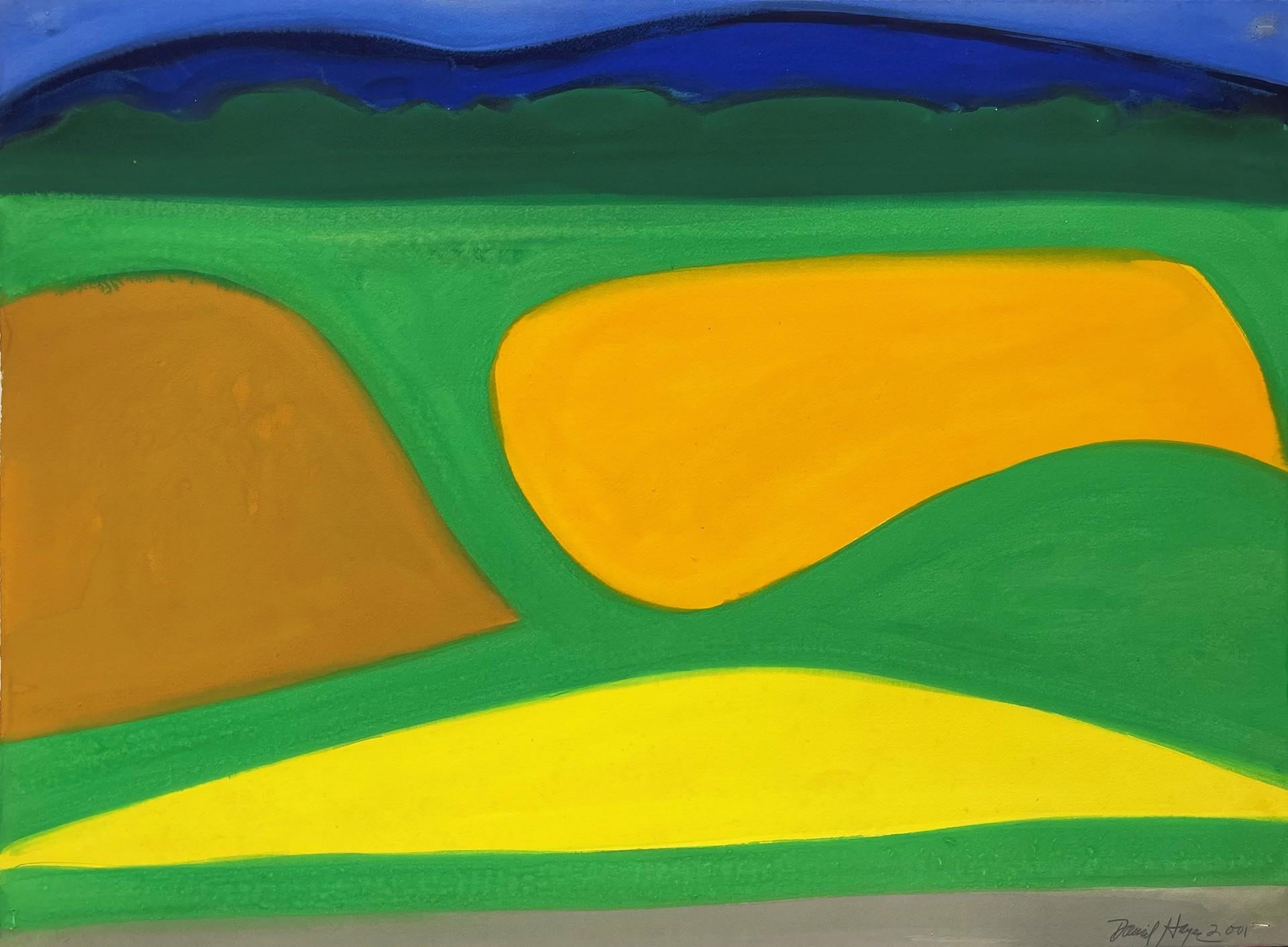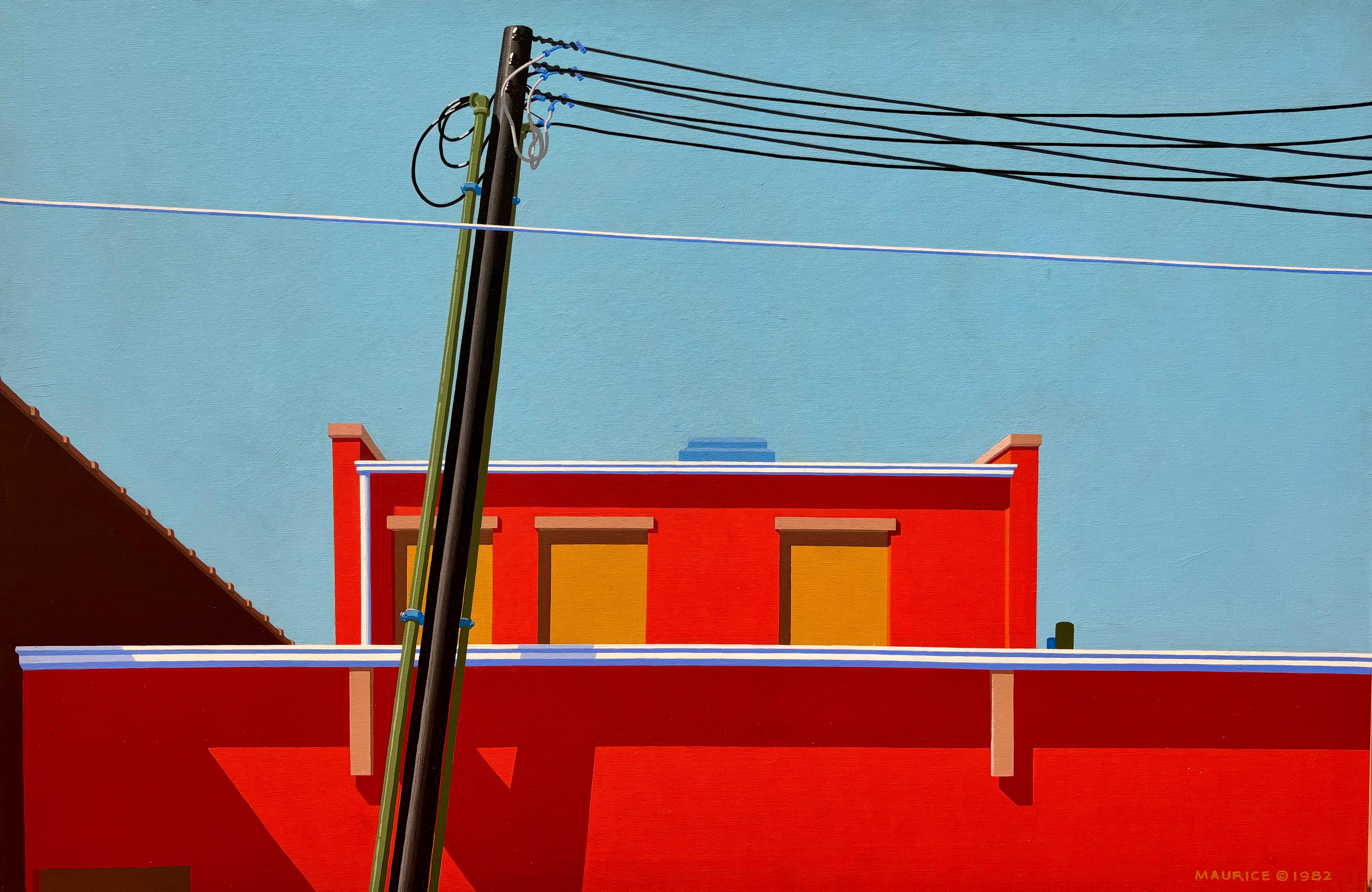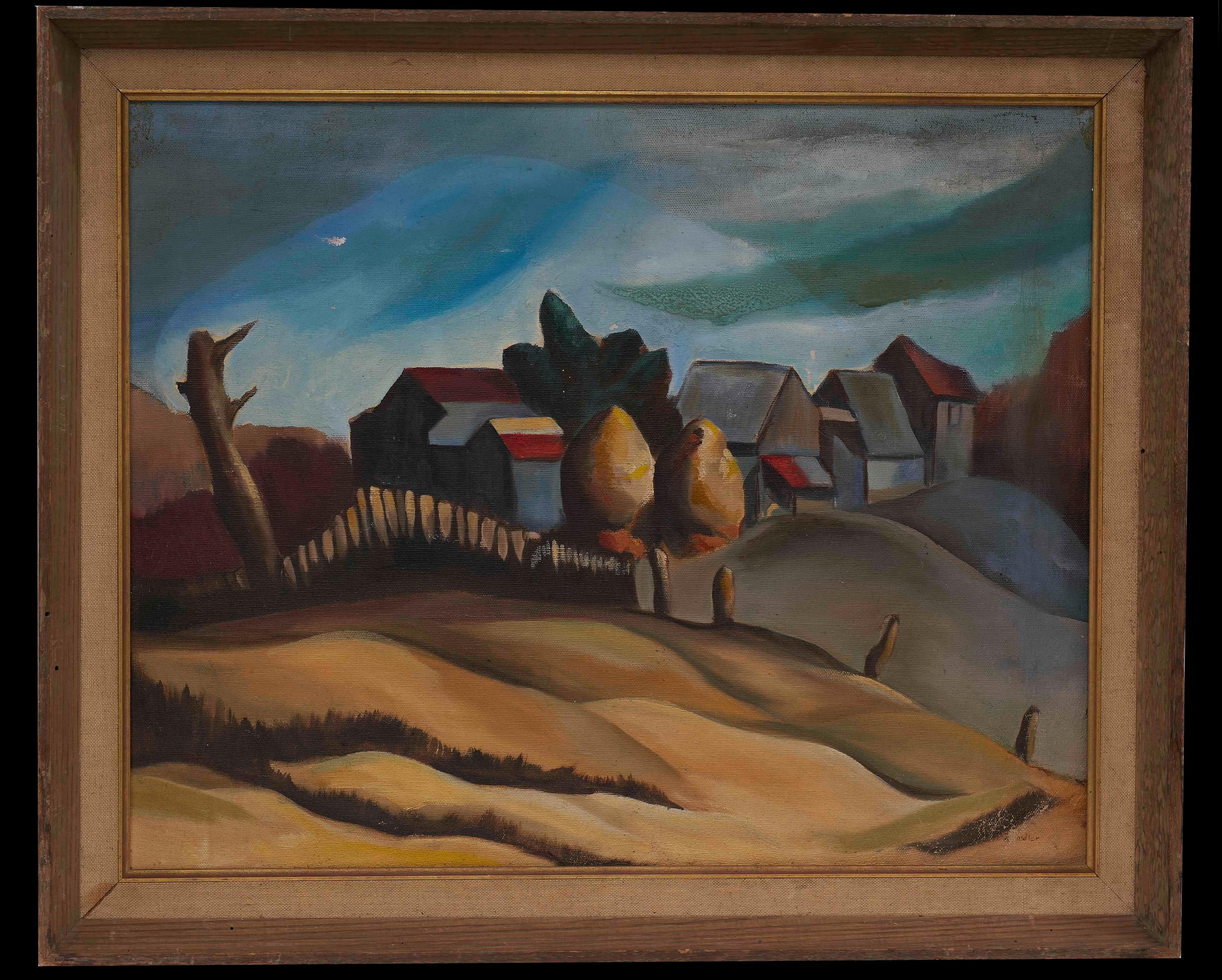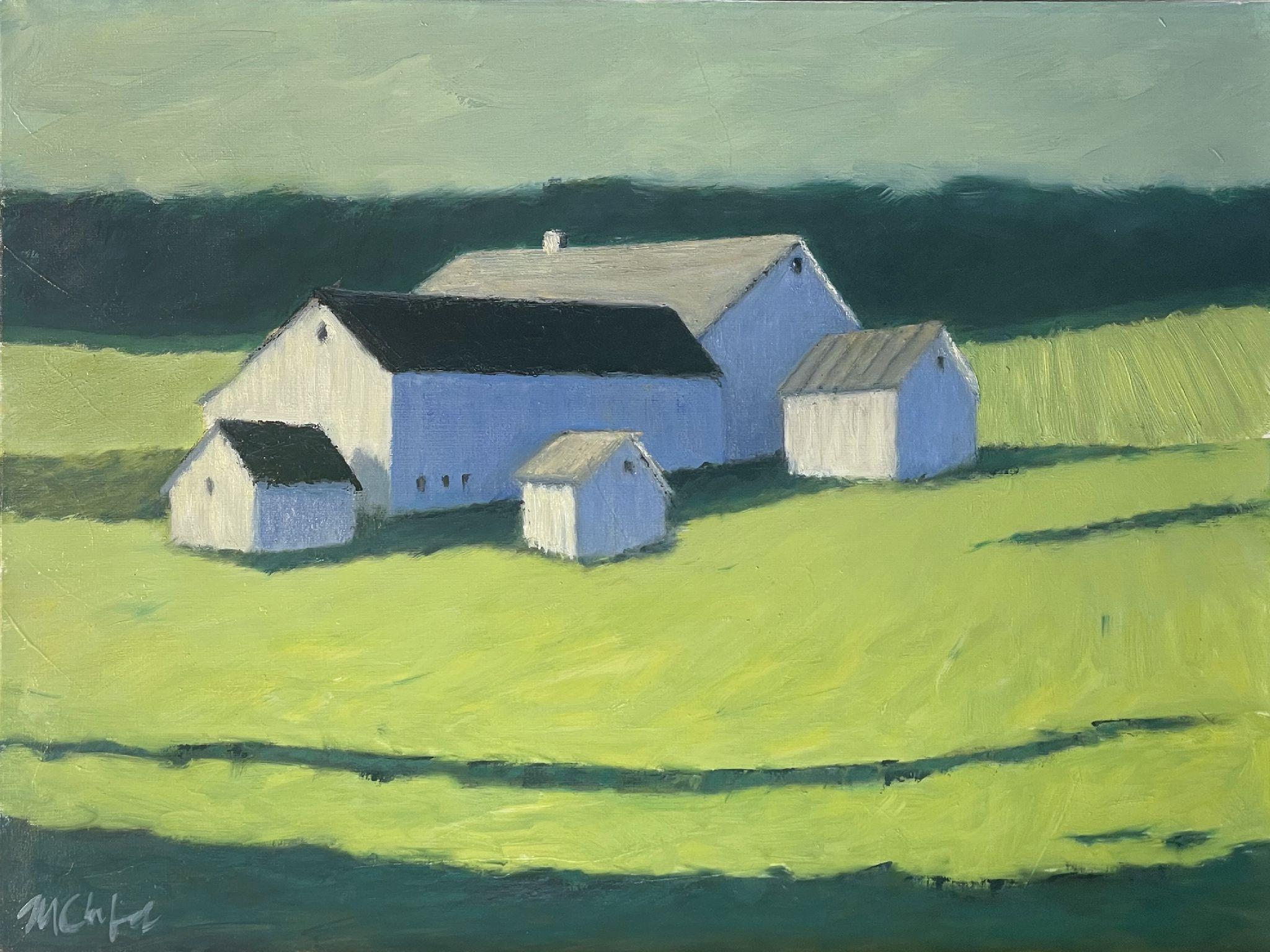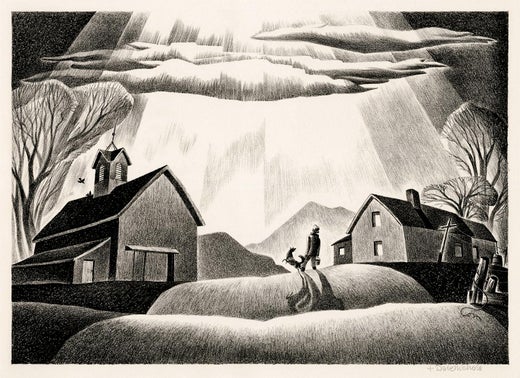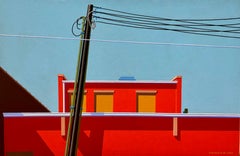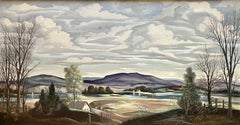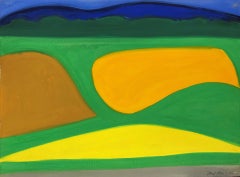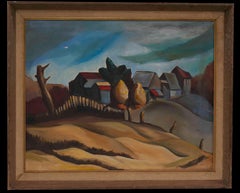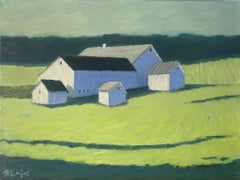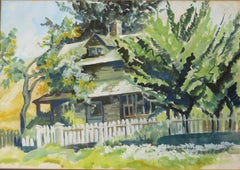Want more images or videos?
Request additional images or videos from the seller
1 of 5
Dale NicholsRFD#11937
1937
$75,000
£56,899.55
€65,238.66
CA$106,841.97
A$115,949.83
CHF 61,007.83
MX$1,408,793.55
NOK 763,806.52
SEK 719,193.33
DKK 487,107.71
About the Item
RFD #1, 1937, oil on canvas, signed and dated lower right, titled verso, 24 x 30 inches
Iowa had Grant Wood. Missouri had Thomas Hart Benton. Kansas had John Steuart Curry. And, Nebraska had Dale Nichols. Although not as well known as the big three regionalists who captured America’s artistic attention during the 1930s, Dale Nichols was an important chronicler of his home state as well as the broader Midwest. Stylistically, Nichols is known for his spare, idealized portrayals of Nebraska farms—his simplified compositions often feature red barns, sweeping snowscapes, and long shadows—evoking both memory and myth. His palette and forms convey serenity and nostalgia, capturing Midwestern “spirit” with restraint and clarity.
RFD #1 includes many aspects of Nichols' regionalist iconography, but it goes beyond the typical work through its inclusion of an automobile driven by a mail carrier. RFD stands for Rural Free Delivery. a transformative program initiated by the United States Post Office Department (now USPS) to deliver mail directly to rural farm families. Before RFD, rural residents had to travel long distances to retrieve their mail from post offices or pay private carriers. The introduction of RFD in the Progressive Era in the late 19th century marked a major expansion of federal services into rural America, with wide-ranging economic, social, and political consequences. After starting in 1896 with tests in West Virginia, Tennessee and Illinois, Rural Free Delivery expanded nationwide in 1902, just two years before Nichols birth, and by 1913, it included parcel service, which allowed farmers and rural residents to receive packages and goods by mail, transforming rural consumer access to manufactured products and helping grow businesses like Sears, Roebuck & Co. RFD integrated rural Americans more fully into the national economy, reduced isolation, boosted rural literacy (through access to newspapers and books), and supported the growth of mail-order businesses.
During the New Deal at the height of Nichols' artistic practice, RFD played a crucial role in the federal government’s broader efforts to modernize rural America, alleviate poverty, and integrate isolated communities into the national economy and culture. While RFD was already well established by the 1930s, the New Deal significantly expanded and transformed its scope and infrastructure, aligning it with President Franklin D. Roosevelt’s vision of a more equitable and connected nation. RFD was critical in delivering New Deal information—farmers and rural families received government bulletins, agricultural extension pamphlets, Works Progress Administration (WPA) project announcements, and materials about programs like the Agricultural Adjustment Administration (AAA) and the Civilian Conservation Corps (CCC). The New Deal emphasized infrastructure investment, and rural roads—essential for mail carriers. Mail routes provided employment for thousands of postal workers and indirectly stimulated road construction and vehicle maintenance jobs, especially in underserved areas. RFD also helped implement the New Deal’s goal of fostering a more unified American identity. By linking remote communities to the federal government and national media, it reduced regional disparities and strengthened allegiance to federal institutions.
Nichols would have been well aware of the positive impacts of Rural Free Delivery as depicted in the present work. Born in the tiny town of David, Nebraska, Nichols came from a loving family who supported his artistic ambitions as much as they expected him to work hard on the family farm for much of the first twenty years of his life. In 1924, Nichols decamped to Chicago and spent a few months at the Chicago Academy of Fine Arts before deciding that real world illustration and graphic arts experience would serve him well. Nichols worked as a commercial artist for fifteen years as his fine art career advanced. In 1934, his painting, End of the Hunt, won the William Randolph Hearst Prize at the Chicago Art Institute and the painting was later purchased by, and remains in the collection of, the Metropolitan Museum of Art. The following year Nichols published his first book, Philosophy of Esthetics, which began to set forth the design principles that Nichols would follow through much of his career.
In addition to painting his native Midwest, Nichols painted in Alaska, Arizona, and later in Mexico and Central America. Nichols exhibited extensively during the 1930s and 1940s, including at New York’s prominent MacBeth Gallery. In 1939 and 1940, Nichols served as artist-in-residence at the University of Illinois. He started working as an illustrator for Encyclopedia Britannica in 1943 and in 1945, he became its Art Director. Although Nichols painted many scenes of Central America, throughout his career, he often returned to the Midwestern landscape for inspiration, working and reworking compositions from his younger days. Nichols works are in the collections of many American institutions, including the Art Institute of Chicago, the Dayton Art Institute, the Metropolitan Museum of Art, the Joslyn Museum, the Minneapolis Institute of Arts, and the Williams College Art Museum, among many others. He is listed in Who Was Who in American Art and all other standard references.
- Creator:Dale Nichols (1904-1995, American)
- Creation Year:1937
- Dimensions:Height: 24 in (60.96 cm)Width: 30 in (76.2 cm)Depth: 1.5 in (3.81 cm)
- More Editions & Sizes:24 x 30 inchesPrice: $75,000
- Medium:
- Movement & Style:
- Period:
- Condition:
- Gallery Location:Los Angeles, CA
- Reference Number:1stDibs: LU1859216792482
Dale Nichols
Artist, printmaker, illustrator, watercolorist, designer, writer and lecturer, Dale Nichols did paintings that reflected his rural background of Nebraska where he was born in David City, a small town. Although he did much sketching outdoors, most of his paintings were completed in his studio and often included "numerology, magic squares and psychic symbols." (Zellman 912) His painting The End of the Hunt (undated) won the Hearst Award at a 1930s exhibition at the Art Institute of Chicago. In the 1960s, he traveled to Guatemala where he was much impressed by the lushness of the landscape and the Spanish and Mayan's culture. These interests were also reflected in his artwork. As a commercial artist, Nichols was an advocate of upgrading the quality of art in illustration and advertising. In 1935, his book elaborating his theories of art, A Philosphy of Esthetics, was published, and in 1957, he completed his book Figure Drawing, published by Watson-Guptill. Nichols, succeeding Iowa artist Grant Wood, was art editor of the Encyclopedia Britannica from 1942 to 1948, and in 1930-40, served as Carnegie visiting professor to the University of Illinois. As an early champion of good art in advertising and illustration, he created artwork for direct-mail industrial advertising in the 1930s and 40s. Nichols studied at the Chicago Academy of Fine Arts, the Art Institute of Chicago with Carl Werntz, and with Joseph Binder in Vienna. During his career, he had eighteen solo exhibitions and exhibited in more than eighty regional and national exhibitions.
About the Seller
5.0
Gold Seller
Premium sellers maintaining a 4.3+ rating and 24-hour response times
1stDibs seller since 2022
17 sales on 1stDibs
Typical response time: <1 hour
- ShippingRetrieving quote...Shipping from: Los Angeles, CA
- Return Policy
Authenticity Guarantee
In the unlikely event there’s an issue with an item’s authenticity, contact us within 1 year for a full refund. DetailsMoney-Back Guarantee
If your item is not as described, is damaged in transit, or does not arrive, contact us within 7 days for a full refund. Details24-Hour Cancellation
You have a 24-hour grace period in which to reconsider your purchase, with no questions asked.Vetted Professional Sellers
Our world-class sellers must adhere to strict standards for service and quality, maintaining the integrity of our listings.Price-Match Guarantee
If you find that a seller listed the same item for a lower price elsewhere, we’ll match it.Trusted Global Delivery
Our best-in-class carrier network provides specialized shipping options worldwide, including custom delivery.More From This Seller
View AllUntitled
Located in Los Angeles, CA
Untitled, c. 1940s, oil on Masonite, signed lower right, 19 ¾ x 25 ¾ inches
Ava Vorhaus Gabriel was a New York-based painter, lithographer, and designer. Born in Larchmont, Gabriel ...
Category
1940s American Modern Landscape Paintings
Materials
Masonite, Oil
Atilt
Located in Los Angeles, CA
Atilt, 1982, acrylic on canvas, 32 x 48 inches, signed and dated lower right, “Alfred P. Maurice 2725 A South Michigan Ave, Chicago, IL, 60616” inscribed verso, “ATILT” inscribed verso, “Maurice.018” inscribed on frame, exhibited: 1) Alfred P. Maurice Artist in the City Paintings 1979 - 1997, Archer Gallery of Clark College, Vancouver, WA, April 8 – April 30, 1997, #11, and 2) An Artful Life: Celebrating the Life of Creator, Teacher, and Collector Alfred Maurice...
Category
1980s American Modern Landscape Paintings
Materials
Canvas, Acrylic
Landscape
Located in Los Angeles, CA
Landscape, c. 1930-40s, oil on panel, signed lower right, 16 x 20 inches
Jeanette Maxfield Lewis was a California-based landscape painter and etcher. Born in Oakland, she spent much...
Category
1930s American Modern Landscape Paintings
Materials
Oil, Panel
Blue Lake
By George Marinko
Located in Los Angeles, CA
This painting is part of our exhibition America Coast to Coast: Artists of the 1940s.
Blue Lake, c. 1940s, oil on masonite, signed lower right, 20 x 36 inches, label and inscriptio...
Category
1940s American Modern Paintings
Materials
Masonite, Oil
Peck Slip
Located in Los Angeles, CA
Peck Slip, 1950, oil on cardboard, 15 x 20 inches, exhibition label verso reads: “Oil on cardboard, 20 x 15, 1950 / Title: Peck Slip / Price: $100 / Artist and Owner: Fiske Boyd / 30...
Category
1950s American Modern Landscape Paintings
Materials
Oil, Board
Six O'Clock
Located in Los Angeles, CA
Six O-Clock, c. 1942, oil on canvas, 30 x 20 inches, signed and titled several times verso of frame and stretcher (perhaps by another hand), marked “Rehn” several times on frame (for the Frank K. M. Rehn Galleries in New York City, who represented Craig at the time); Exhibited: 1) 18th Biennial Exhibition of Contemporary American Oil Paintings from March 21 to May 2, 1943 at The Corcoran Gallery of Art in Washington, D.C. #87, original price $450 (per catalog) (exhibition label verso), 2) Craig’s one-man show at the Frank K. M. Rehn Galleries, New York City, from October 26 to November 14, 1942, #10 (original price listed as $350); and 3) Exhibition of thirty paintings sponsored by the Harrisburg Art Association at the State Museum of Pennsylvania in Harrisburg in March, 1944 (concerning this exhibit, Penelope Redd of The Evening News (Harrisburg, Pennsylvania) wrote: “Other paintings that have overtones of superrealism inherent in the subjects include Tom Craig’s California nocturne, ‘Six O’Clock,’ two figures moving through the twilight . . . .” March 6, 1944, p. 13); another label verso from The Museum of Art of Toledo (Ohio): original frame: Provenance includes George Stern Gallery, Los Angeles, CA
About the Painting
Long before Chris Burden’s iconic installation outside of the Los Angeles County Museum of Art, Urban Light, another artist, Tom Craig, made Southern California streetlights the subject of one of his early 1940s paintings. Consisting of dozens of recycled streetlights from the 1920s and 1930s forming a classical colonnade at the museum’s entrance, Burden’s Urban Light has become a symbol of Los Angeles. For Burden, the streetlights represent what constitutes an advanced society, something “safe after dark and beautiful to behold.” It seems that Craig is playing on the same theme in Six O-Clock. Although we see two hunched figures trudging along the sidewalk at the end of a long day, the real stars of this painting are the streetlights which brighten the twilight and silhouette another iconic symbol of Los Angeles, the palm trees in the distance. Mountains in the background and the distant view of a suburban neighborhood join the streetlights and palm trees as classic subject matter for a California Scene painting, but Craig gives us a twist by depicting the scene not as a sun-drenched natural expanse. Rather, Craig uses thin layers of oil paint, mimicking the watercolor technique for which he is most famous, to show us the twinkling beauty of manmade light and the safety it affords. Although Southern California is a land of natural wonders, the interventions of humanity are already everywhere in Los Angeles and as one critic noted, the resulting painting has an air of “superrealism.”
About the Artist
Thomas Theodore Craig was a well-known fixture in the Southern California art scene. He was born in Upland California. Craig graduated with a degree in botany from Pomona College and studied painting at Pamona and the Chouinard Art School with Stanton MacDonald-Wright and Barse Miller among others. He became close friends with fellow artist Milford Zornes...
Category
1940s American Modern Landscape Paintings
Materials
Canvas, Oil
$12,500
You May Also Like
Study for Landscape
By David Hayes
Located in Fort Lauderdale, FL
David Hayes (1931 - 2013)
Study for Landscape, 2001
Gouache on paper
22.25 x 30 in
Category
Early 2000s Contemporary Paintings
Materials
Gouache
Price Upon Request
American Regionalist Landscape Painting by Very Talented Mystery Artist Signed
Located in San Francisco, CA
American Regionalist Landscape Painting by Very Talented Mystery Artist
Signed Lower Right
Early 20th century
In good vintage condition with areas of paint loss
Oil on Canvas
...
Category
20th Century Landscape Paintings
Materials
Canvas, Oil
Miller Craig Farm
By Maureen Chatfield
Located in Greenwich, CT
American, b. 1948
Artist Statement:
"My paintings are intuitive responses to the myriad forces that shape my life—emotions that translate into color, visual memories of forms and c...
Category
2010s Contemporary Landscape Paintings
Materials
Canvas, Oil
Untitled
By Ruth Armer
Located in San Francisco, CA
Artist: Ruth Armer – American (1896-1977)
Title: Untitled
Year: circa 1940
Medium: Watercolor and gouache on paper
Sight size: 13.75 x 19.5 inches.
Framed ...
Category
Mid-20th Century Modern Landscape Paintings
Materials
Paper, Watercolor, Gouache
Untitled
Located in San Francisco, CA
Artist: Charles Burk– American (1947-)
Title: Doorway, old Building
Year: unknown
Medium: Watercolor on watercolor paper
Size: 10 x 15 inches.
Framed size: 19 x 23.5 inches
Signatu...
Category
Late 20th Century Modern Landscape Paintings
Materials
Paper, Watercolor
North Street
By Virginia Tillou
Located in Buffalo, NY
An original modern landscape painting by American female artist Virginia Tillou.
Category
1950s Modern Landscape Paintings
Materials
Canvas, Oil
$2,240 Sale Price
20% Off
